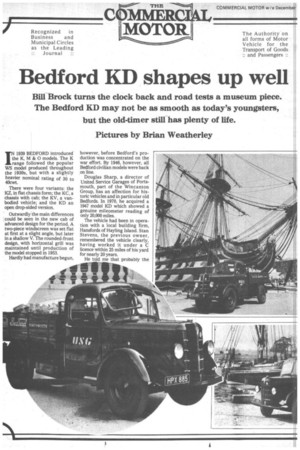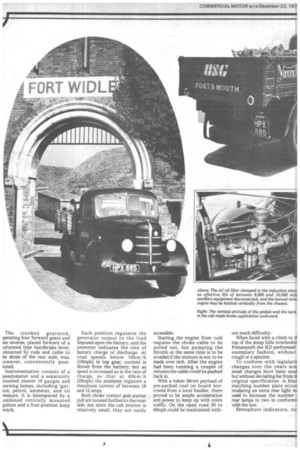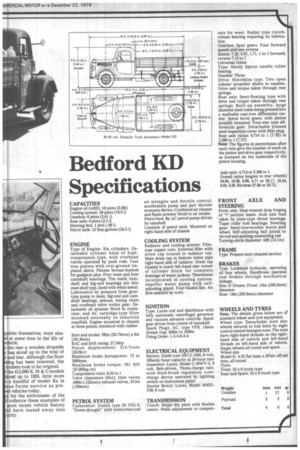Bedford KD shapes up well
Page 40

Page 41

Page 42

Page 43

If you've noticed an error in this article please click here to report it so we can fix it.
Bill Brock turns the clock back and road tests a museum piece. The Bedford KD may not be as smooth as today's youngsters, but the old-timer still has plenty of life.
Pictures by Brian Weatherley
rti1939 BEDFORD introduced he K, M & 0 models. The K range followed the popular WS model produced throughout the 1930s, but with a slightly heavier nominal rating of 30 to 40cwt.
There were four variants: the KZ, in flat chassis form; the KC, a chassis with cab; the KV, a vanbodied vehicle; and the KD an open drop-sided version.
Outwardly the main differences could be seen in the new cab of advanced design for the period. A two-piece windscreen was set flat at first at a slight angle, but later in a shallow V. The rounded-front design, with horizontal grill was maintained until production of the model stopped in 1953.
Hardly had manufacture begun, however, before Bedford's production was concentrated on the war effort. By 1946, however, all Bedford civilian models were back on line.
Douglas Sharp, a director of United Service Garages of Portsmouth, part of the Wincanton Group, has an affection for historic vehicles and in particular old Bedfords. In 1970, he acquired a 1947 model KD which showed a genuine mileometer reading of only 20,000 miles.
The vehicle had been in operation with a local building firm, Hansfords of Hayling Island. Stan Stevens, the previous owner, remembered the vehicle clearly, having worked it under a C licence within 25 miles of his yard for nearly 20 years.
He told me that probably the longest journey the KD had made was from the factory at Luton to the south coast when new, but could not be absolutely sure as it was four years old when he had bought it.
Working locally accounted for the low mileage, averaging out at less than 1000 a year. Stan might have been running it yet, but for the introduction of the Ministry plating and testing regulations which made continued use impractical.
A 22-cwt CF replaced the KD and that now averaged much the same annual mileage. By the year 1990 it too may become a collectors' item.
Even in those far-off preconservationist days, a low fuel consumption, long life and performance were criteria to be strived for. To these ends a new six-cylinder petrol engine was introduced with improved power and torque of 54kW (72bhp) at ,3000rpm and 218Nm (161 lbft) at 1200 rpm enabling drive to be transmitted to a rear axle with a geared ratio some 10 per cent higher than had been used before.
A CM report at the time explained it this way: "By these means, three objectives have been attained. The engine, which to begin with is an economical unit, runs at a lower speed and therefore consumes less fuel and gains durability. Its greater power results in higher torque and rate of doing work at the rear wheels despite the raised final drive gear; hence the better performance in respect of acceleration and speed.
"It is claimed by the company that models in the new series will give increases of mileage per gallon ranging from 5 to 15 per cent."
Some interesting engineering developments included a fully counterbalanced four-bearing crankshaft, oil lubrication to the cylinder walls from a pressurised supply via the big ends, and corresponding holes in the crank pins.
Both big-end and main bearings had detachable steel back liners in place of white metal A modified water pump incorporated a Celeron disc and a springtensioned rubber washer to prevent water loss from the gland.
The spindle ran in a permanently sealed ball race. A thrust bearing in the clutch replaced the carbon-ring withdrawal gear, but the gearbox remained unaltered.
As today, weights were an important consideration with the possibility of a plating scheme becoming law. So for the first time Bedford specified the maximum gross weight for all its new models.
Peter Gormlay, the man responsible for the vehicle's excellent state of preservation, accompanied me during my drive around Portsmouth. Fortunately old habits die hard, and my natural inclination to double declutch assisted in making clean down changes through the b( avoiding, for the most part, al nerve-shattering grating noises. Upward gearchang. necessitated only a single cluti pedal depression and could I made quietly and smoothly wi only a hint of hesitation on pa sing through the neutral positio At the outset the steerit seemed heavy and remained E easing only slightly once on ti move.
The vertical inclination of tl foot pedals, which made brakii more difficult, would be a sour of complaint for today's drivers We tend to think of split bral systems as a modern innovatic but here we have a vehicle, co ceived in the Thirties, with straight hydraulic syste activated by a tandem mast cylinder isolating the front al rear circuits.
Servo, included on heavi models, was not specified on tl KD range, which left the driver cope aided by a little mechanic assistance. A strong right leg w, an undoubted asset.
The cab is somewhat sputa but accepted at a time when ti only form of heating was providi by a tea flask. For warmer da. ventilation can be gained i raising a hinged front screen, be opened only part way so as avoid both the full blast of travt ling at 30mph and the inse population carried with it. Dri side windows fitted within ti doors stayed more or less as c iginally set. " In the Forties ergonomics wa: science in its infancy, with ti driver forced to sustain an u comfortable and dangerous i timacy with the steering whe particularly testing nowadays f the man used to the relati. luxury of present-day machines The cranked gearstick, • perating four forward gears and Ine reverse, placed forward of a torizontal type handbrake lever, onnected by rods and cable to he shoes of the rear axle, was, iowever, conveniently posiioned.
Instrumentation consists of a peedometer and a separately aounted cluster of gauges and yarning lamps, including igniion, petrol, ammeter, and oil ressure. It is interspaced by a ombined centrally mounted ;nition and a four-position lamp witch. Each position regulates the generator output to the load imposed upon the battery, and the ammeter indicates the rate of battery charge or discharge. At road speeds below 16km /h (10mph) in top gear, current is drawn from the battery; but as speed is increased so is the rate of charge, so that at 40km/h (25mph) the ammeter registers a maximum current of between 10 and 12 amps.
Both choke control and starter pull are located further to the near side, but since the cab interior is relatively small, they are easily accessible.
Starting the engine from cold requires the choke cable to be pulled out, but pumping the throttle at the same time is to be avoided if the mixture is not to be made over rich. After the engine had been running a couple of minutes the cable could be pushed back in.
With a token 30cwt payload of pre-packed coal on board borrowed from a local haulier, there proved to be ample acceleration and power to keep up with town traffic. On the open road 30 to 40mph could be maintained with out much difficulty.
When faced with a climb to tt top of the steep hills overlookir Portsmouth the KD performed ; exemplary fashion, without cough or a splutter.
To conform with legislatiN changes over the years soni small changes have been mad but without deviating far from t.,1 original specification. A blan matching number plate accon modating an extra rear light wi used to increase the number rear lamps to two in conformil with the law.
Semaphore indicators, no ies themselves, were also at some time in thelife of icle, he rear a wooden dropside as stood up to the trial of nd tear. Although the floor g has been renewed, the bers look to be original.
e 412,000 K. M ac 0 models up to 1953, little more handful of model Ks in s forms survive as prevehicles today.
for the enthusiasm of the collector these examples of ore recent vehicle history have rusted away into nty.




















































































